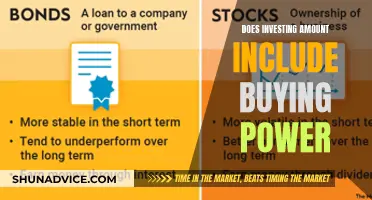
Investing for retirement without an advisor is a viable option for those who can't afford, don't trust, or simply don't want to use an advisor. There are several ways to go about this, including investing in tax-advantaged accounts, understanding asset allocation, and considering robo-advisors or target-date funds for easy management. Here is an introduction to get you started on your retirement investing journey:
Investing for retirement is a crucial aspect of financial planning, and it is possible to navigate this process without relying on a financial advisor. By taking a do-it-yourself approach, individuals can save on advisor fees and maintain control over their retirement finances. This introduction will outline some key strategies for investing for retirement without an advisor, providing a starting point for further exploration and personalized planning.
One of the fundamental steps is to start saving for retirement as early as possible, taking advantage of the power of compounding returns over time. Additionally, it is essential to understand the various investment vehicles available, such as stocks, mutual funds, and retirement accounts like 401(k)s and IRAs. These accounts offer tax advantages, with traditional IRAs providing tax deductions during the contribution years, and Roth IRAs offering tax-free withdrawals in retirement.
It is also crucial to assess your risk appetite and choose investments that align with your tolerance for financial risk. This may involve diversifying your portfolio across different asset classes, such as stocks, bonds, and alternative investments. By adopting a sensible plan and staying disciplined, individuals can effectively manage their own retirement investments and work towards a secure financial future.
| Characteristics | Values |
|---|---|
| Retirement accounts | 401(k), IRA, SEP, SIMPLE, Solo 401(k), Profit-sharing plans, Brokerage account |
| Investment types | Mutual funds, Index funds, ETFs, Stocks, Bonds, Annuities, Real estate, Small business, CDs, Dividend stocks, Rental property |
| Investment strategies | Robo-advisors, Target date funds, Asset allocation, Dividend investing |
| Tax advantages | Tax-deferred, Tax-free, Tax-deductible |
What You'll Learn

Understand tax-advantaged accounts
Tax-advantaged accounts are a great way to save money on taxes while investing for retirement. They are designed to help you invest funds for retirement while minimising tax liabilities. These accounts can be employer-sponsored, like a 401(k) or 403(b), or privately held, like an Individual Retirement Account (IRA).
Tax-Deferred Accounts
Tax-deferred accounts allow you to reduce your taxable income now and pay taxes on your investments later. Examples of tax-deferred accounts include traditional IRAs and 401(k) plans. With these accounts, you can deduct your contributions from your taxable income in the year you make them, but you will pay taxes on your withdrawals in retirement. This can be a great option if you expect your tax rate to be lower in retirement than it is currently.
Tax-Exempt Accounts
Tax-exempt accounts, on the other hand, are funded with after-tax dollars, and the investments grow tax-free. Examples of tax-exempt accounts include Roth IRAs and Roth 401(k) plans. With these accounts, you don't get an immediate tax deduction, but your withdrawals in retirement are tax-free. This can be a good option if you expect your tax rate to be higher in retirement.
Health Savings Accounts (HSAs)
HSAs are another type of tax-advantaged account that can be used to pay for qualified medical expenses. Contributions to an HSA are often made with pre-tax dollars, and the funds grow tax-free. Withdrawals are also tax-free as long as they are used for qualified medical expenses. HSAs can be a great way to save for healthcare costs while also reducing your tax burden.
529 Plans
529 plans are tax-advantaged accounts designed to save for education expenses. Contributions may be made with pre-tax or after-tax dollars, depending on the state, and the funds grow tax-free. Withdrawals are also tax-free as long as they are used for qualified education expenses. 529 plans can be a great way to save for college while also reducing your tax liability.
Other Tax-Advantaged Accounts
There are also other types of tax-advantaged accounts available, such as Coverdell Education Savings Accounts, Flexible Spending Accounts (FSAs), and ABLE accounts. Each of these accounts has its own rules and eligibility requirements, so be sure to do your research to determine which accounts are best for your situation.
Strategic Retirement: Navigating the Best Investment Options for Your $450,000
You may want to see also

Learn about asset allocation
Asset allocation is a strategy that helps you decide how much money to put into stocks, bonds, and cash when investing for retirement. It involves striking a balance between these three core asset classes.
As a rule of thumb, younger investors can tolerate more risk, but they often have less income to invest. Older investors, on the other hand, may have more money to invest but less time to recover from losses. Thus, it is recommended that you shift towards more conservative investments once you retire, as you no longer have an active income to replace losses. However, since you will need this money for decades, you shouldn't completely abandon growth-oriented positions.
- 20s & 30s: 80-100% stocks, 0-20% bonds
- 40s: 80-100% stocks, 0-20% bonds
- 50s: 65-85% stocks, 15-35% bonds
- 60s: 45-65% stocks, 30-50% bonds, 0-10% cash/cash-equivalents
- 70s: 30-50% stocks, 40-60% bonds, 0-20% cash/cash-equivalents
It is important to note that your asset allocation should be based on your personal risk tolerance, financial goals, and investment timeline. For example, if you are planning to retire early, you may want to adjust your asset allocation accordingly. Additionally, you should periodically review and rebalance your portfolio to ensure it aligns with your changing needs and goals.
Local Superfund Sites: Worthy Investment Opportunities
You may want to see also

Consider robo-advisors
Robo-advisors are automated platforms that use algorithms to match you with investments based on your comfort with risk and your time frame. They are a hybrid stock broker and investment advisor in one. They are also referred to as "automated investment advisors" or "digital advice platforms".
Robo-advisors are a good option for those who want to invest for retirement without an advisor because they are known for the low amount of money it takes to get started. Some do not have account balance minimums, which helps to lower the entry point for people who want to use them to invest. They are also a good option for those who want to invest without having to do extensive research or make their own trades.
- They are easy to set up and fund an account
- They are low-cost and perform almost the same service as asset management firms
- They provide instant diversification, allowing you to invest in an array of products
- They remove the potential for firms to push their own products or let biases affect their advice
- Most robo-advisors lack the personal touch of a human advisor
- They cannot assess whether it makes sense to save for urgent needs, pay down debt, or invest for long-term goals
- They cannot replace personal planning advice or get rid of the prospect that you will make an emotional decision with your money
- Many platforms lack intuitive risk assessments, so it is important to do additional research to fully capture your risk tolerance
- Some robo-advisors may not give advice on earning income through drawdown, which is important for retirees
- Betterment: One of the earliest robo-advisors, Betterment has annual management fees starting at 0.25% for portfolios under $100,000 and 0.40% for portfolios above this amount. It offers a range of portfolio options and supports IRA accounts.
- M1 Finance: A combination of an online broker and a robo-advisor, M1 Finance lets you invest in stocks and ETFs on your own or use prebuilt portfolios. There are no trading fees or automated investing fees.
- Empower: Empower uses a hybrid of computer technology and a human advisor to manage your investments. However, you need to invest at least $100,000 to use their wealth management service, and fees start at 0.89% annually for portfolios under $1 million.
- Wealthfront: Wealthfront charges 0.25% in annual management fees and lets you customize your portfolios.
- Vanguard Digital Advisor: This robo-advisor invests in a range of low-cost Vanguard ETFs to suit your goals and risk tolerance. There is a $3,000 minimum requirement to open an account, and annual advisory fees of up to 0.20%.
While robo-advisors can be a helpful tool for retirement planning, it is important to do your own research and consider your unique financial situation before making any investment decisions.
Planning for the Longevity of Your Retirement Investments
You may want to see also

Explore dividend-paying stocks
Dividend-paying stocks can be a great source of passive income for retirement. They provide a steady stream of cash without the need to dip into your principal savings. Dividend-focused investing has also demonstrated the ability to lower volatility and buffer losses during market downturns.
Dividend stocks are shares in companies that pay investors a portion of their profits at regular intervals, usually quarterly. Not all companies pay dividends, so not all stocks are dividend stocks. Dividends can be paid out as cash or additional stock. While dividends are not guaranteed, they tend to be sustained over long periods as missing dividend payments can be a sign of poor financial health.
- Income and asset growth: Dividend stocks provide steady income, and the value of the stock typically rises over time. This double benefit means your money can grow in two ways. However, the stock price for dividend-paying companies may grow more slowly than other stocks, if at all.
- Hedging inflation: Dividends can increase over time, helping your retirement income keep pace with inflation.
- Risk and volatility: Dividend stocks are usually also value stocks, which are relatively stable and safe companies. They tend to be more established, larger, and more mature companies with consistent profits. However, individual stocks can still be risky, even if they are value stocks. It's important to choose your dividend investments carefully and ensure proper diversification.
- Tax advantages: Dividends can have tax advantages. Qualified dividends from certain companies may be taxed at lower rates than ordinary income. Additionally, if you hold dividend stocks in a Roth IRA or Roth 401(k), the dividend income grows tax-free.
- Double taxation: One criticism of dividend-producing stocks is that dividend payments are taxed twice—once at the corporate level and again as personal income tax for the investor.
- Dividend policy changes: It's important to remember that dividend policies can change over time. Companies are not obligated to maintain their dividend policies and may change or eliminate them.
When considering dividend-paying stocks, it's essential to assess your risk tolerance and investment goals. While dividend stocks can provide a steady income stream, they may offer lower capital appreciation potential compared to more aggressive equity investments. Additionally, some sectors with dividend-paying stocks, such as utilities and banks, can be sensitive to interest rate changes and sector-specific risks.
To enhance diversification and lower risk, you may want to explore dividend exchange-traded funds (ETFs). These funds bundle together a diverse range of dividend-paying stocks, offering investors a convenient way to access a diversified portfolio with regular income distributions. Dividend ETFs also provide greater diversification and lower risk compared to individual dividend stocks.
Options: Why Investors Are Wary
You may want to see also

Invest in real estate
Investing in real estate is a popular way to save for retirement. Here are some options for how to do it:
Own Your Home
For most people, their home is their most valuable asset, so it can be a good idea to include it in your retirement plans. You can consider downsizing, or using the equity in your home to fund long-term care.
Real Estate Investment Trusts (REITs)
A Real Estate Investment Trust (REIT) is a collection of properties or other real estate assets that you can buy into, similar to buying a stock or fund. REITs have a special tax status that requires them to pay out at least 90% of their income as dividends. They can be a good way to get the benefits of real estate without the hassle of buying and managing a property yourself.
Buy, Improve and Flip
This strategy involves buying a property, improving it, and then selling it for a profit. It can be profitable, but it can also be a good way to lose money if you don't have the right skills and knowledge.
Purchase Residential or Commercial Property and Rent it Out
This is the most common form of real estate investing. You buy a property and rent it out to long-term tenants, earning income from the rent. It's important to choose a good location and make sure you can cover all the associated costs, including maintenance, taxes, and insurance.
Purchase Commercial Property and Run Your Own Business
If you've dreamed of running your own business, owning the property it's located in can increase your long-term wealth and monthly income.
Buy a Vacation Home and Rent it Out Part-Time
This strategy involves renting out a vacation property to tenants for short periods. It can be a good way to make money, but it may also be more expensive and risky due to the seasonal nature of vacation rentals.
Crowdfunding
Crowdfunding allows you to invest in real estate projects without needing a large amount of capital. You can choose which projects to invest in and sometimes have a say in how the project is run. However, there is a lack of liquidity in this type of investment.
Retirement Planning: 401(k) Investors Count
You may want to see also







